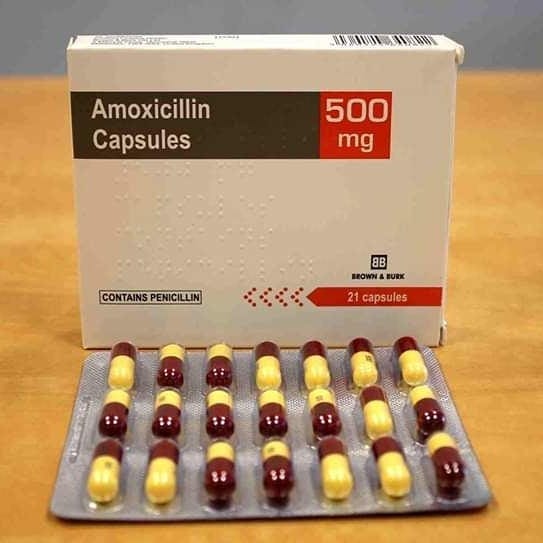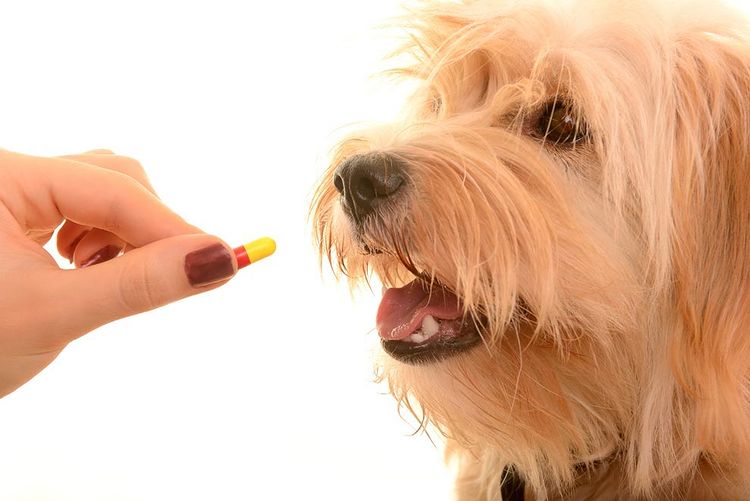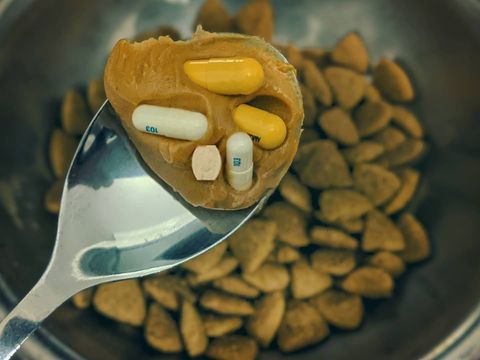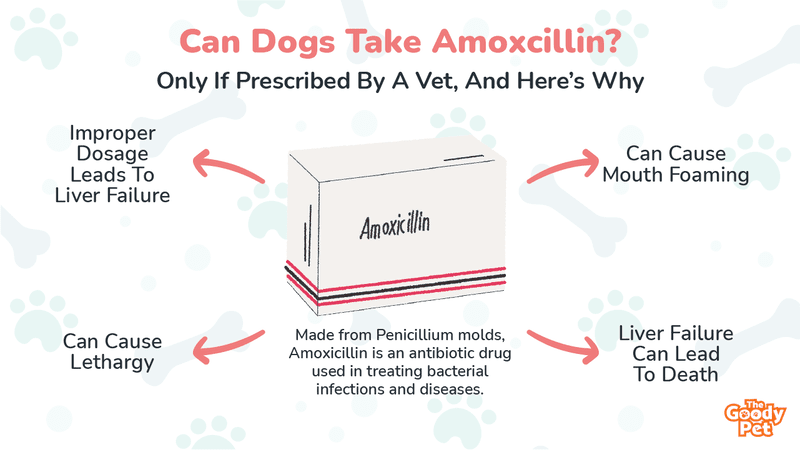If your furry friend suffers from boils or other bacterial infections, you may find yourself popping tablets of amoxicillin to administer to it. But just before you do so, you should consider whether it is safe or not.
Giving dogs amoxicillin is only safe when it is amoxicillin prescribed by a vet for pets. But if you give your canine buddy human amoxicillin without a prescription, you’ll expose it to risks such as liver damage.
If you would like to know more about amoxicillin, its benefits, and potential contraindications on your puppy, please keep reading as I’ve discussed these and more here.
What Is Amoxicillin?

Amoxicillin is an antibiotic drug used in treating bacterial infections and diseases. It’s basically penicillin, a special class of antibiotics made from Penicillium molds. Amoxicillin has a wide antibiotic range, making it perfect for treating many bacterial infections.
Furthermore, although it’s better than ampicillin in terms of absorption speed and effectiveness, some bacteria are resistant to the drug. Nonetheless, it’s pretty much one of the most effective antibiotics.
Amoxicillin is usually orally administered to dogs and exists in tablet or liquid form. Nonetheless, some injections of the drug are available. Typically both the oral and intramuscular administrations come in 125 mg, 250 mg, 500 mg, and sometimes 800 mg and higher concentrations.
In addition, amoxicillin is most effective when combined with clavulanic acid. Clavulanic acid is used with amoxicillin because it increases the drug’s potency. But rather than administering both drugs separately, both are combined in one tablet called amoxicillin-clavulanic acid or, more popularly, Clavamox.
What Is Amoxicillin Used For In Dogs?
Amoxicillin is used to treat abscessed teeth, urinary tract infections, infected wounds, and other infections and diseases caused by bacteria.
Abscessed Tooth Root
When your dog has abscessed teeth, it means there is an infection in one or more of its teeth. It’s a periodontal disease where bacteria enter the space created by damage to a tooth.
Typically, bacteria reside in the mouth of your pet. So when one tooth gets broken, and there’s a little cavity created either in the gum or within the tooth itself, they’ll find a way to get in.
What makes this abscess worse than it may appear is when these microorganisms normally supposed to be washed away begin to affect the internal structure of your dog’s teeth. They’ll eat into the protective structures and cause damage to the roots of its teeth. Sadly, this causes excruciating pain.
While some dogs know how to express their pain, others find it difficult to do so. So rather than seeing your dog wincing in pain, you may see it hurdled in a corner, refusing to eat or play with its chew toys. Furthermore, its teeth may become pussy, and it might drool excessively. Nonetheless, in all cases, a foul smell is accompanied by rotting teeth.
Urinary Tract Infections
Like abscessed teeth, urinary tract infections are rooted in bacteria’s effect on a dog’s urinary system. Unfortunately, female dogs are more susceptible to this disease than males. This susceptibility is mostly because their urinary openings are wider than males.
However, it typically occurs when bacteria enter the urinary tract of your animal. They look for sore tissue and small openings to inhabit and grow when they go in. These bacteria feed off your animal’s urine and are quite comfortable with internal conditions of the urinary area.
When they grow to certain extents, they begin to make your dog uncomfortable. The symptoms of this infection range from smelly urine to your dog licking its genitals regularly and even sore genitals.
In addition, diabetic dogs are susceptible to this disease. Sadly, if the bacteria causing the tract infection migrate to upper areas such as your pooch’s kidneys, then something more serious could occur.
Boils
Boils are the most common form of bacterial infections there are in canines. Boils typically occur when bacteria fill in exposed areas of injured skin. For example, if your canine buddy gets nicked when scratching an itch and bacteria fill the wound, they can grow in numbers and infect the wound.
Eventually, pus will form there and will burst when irritated or pressurized. Dirty dogs are more likely to have boils than other dogs because of their exposure to bacteria regularly.
Respiratory Tract Infections
There is a broad spectrum of respiratory tract bacterial infections. Pneumonia, tonsillitis, and bronchitis are the most common among this wide variety.
Though the species specifically causing these infections are closely linked together, for example, Streptococcus and Haemophilus species, their severity ranges from mild to extreme.
Nonetheless, they are usually pretty terrible, and human transmission isn’t out of the question. Luckily, like the others here, amoxicillin can cure these infections.
Can I Give My Dog Human Amoxicillin?

It would be prudent not to give your dog any human amoxicillin.
Amoxicillin administered to humans is very different from the veterinary formulation. This variation arises from the chemical components used in making human-grade amoxicillin that can be toxic to canines. These chemicals include certain preservatives and other additives such as xylitol that are deadly to dogs.
Xylitol, for instance, is a toxic chemical to dogs. And most brands of human-grade amoxicillin come with it in relatively substantial quantities.
Xylitol is a modified sugar used in making drugs and confectionaries. Why it’s particularly dangerous to dogs is because of its ability to cause hypoglycemia. When a dog consumes xylitol, it’s absorbed rapidly into the bloodstream.
Normally, you’d think that the rapid increase in sugar would lead to problems, but it’s the release of insulin that causes a problem. Because the spike in sugar happens so quickly, its pancreas would release a more than proportionate amount of insulin.
This release would cause a drastic drop in its blood sugar levels to the extent that there wouldn’t be enough glucose to provide energy. This particular condition is what constitutes hypoglycemia.
How Long Does It Take for Amoxicillin To Work In Dogs?
Amoxicillin normally takes about an hour or two to begin to take effect in dogs. Typically, administering one tablet or dose once won’t immediately make the symptoms subside. Thus, it’s best to keep up with the prescription.
What Happens If My Dog Misses A Dose Of Amoxicillin?
If your dog misses one dose of amoxicillin, there isn’t usually a problem. However, if it’s missed more than one dose continuously, the bacteria might eventually become resistant to the drug.
Drug resistance is a big problem in veterinary medicine. Because humanity has enough problems, veterinary medicine is often neglected when it comes to deep research on treating highly resistant species of bacteria.
Most times, these species that form high resistance are peculiar to only a particular individual, especially because of heredity and other factors such as drug abuse.
So, research on developing drugs that tackle these species will take time, effort, and resources. And how many people are just as desperate as you to do so much for their pets?
Furthermore, it will typically take longer to cure the infection if your dog skips doses, so it’s best to avoid this.

Will Amoxicillin Hurt My Dog?
Whether amoxicillin will hurt your furry friend or not depends on many factors. These factors include whether it’s pregnant or not, whether you give it the right kind of amoxicillin, and whether it’s allergic to the drug or not, amongst others.
Pregnant dogs face a huge risk when they take amoxicillin. Most times, taking the drug doesn’t affect them permanently. But the puppies they bear are at stake.
Typically, stillbirths ensue from taking drugs such as amoxicillin that have contraindications with gestation, but in other rare cases, congenital abnormalities may occur in fetuses that make it through.
In addition, as aforementioned, amoxicillin formulated for humans can have dangerous effects on your pooch. Hypoglycemia which could lead to an unexpected untimely demise, is one.
Also, it’s best not to rule out the effects of an allergen on a dog. If you notice that your dog is allergic to amoxicillin, you should cease administering the drug immediately and seek a vet’s help.
Can I Give My Dog Amoxicillin Without A Prescription?
While you can give your dog some amoxicillin without a prescription, you must not because it could cause liver failure, lethargy, and even death.
The effects of drug abuse in animals are just as terrifying as it is in humans. If you feel your dog has a particular condition caused by bacteria, say boils, and you go ahead to pop some amoxicillin tablets and give it, many things could go wrong.
Firstly, you could have administered a concentration of amoxicillin with a different dosage than another whose dosage you probably know. For example, tablets of 500mg amoxicillin don’t have the same dosage as 250mg tablets.
Thus if you go ahead and give your pooch some 500mg tablets the same way you would give it 250mg tablets, this could cause severe side effects such as lethargy, loss of appetite, and even frothing at the mouth.
However, besides death, liver failure is the scariest of these effects. Liver failure typically occurs when the excess administration of a drug poisons your pooch. When this happens, the liver would be overstressed trying to detoxify the blood and, in the process, become damaged.
Liver failure is usually lethal in dogs because it would no longer help purify the blood. Sometimes it can take long before the effects of liver failure kick in. The kidneys, the other organs responsible for filtration, would be overstressed when the liver is no longer functional.
Thus, the stress could get them damaged too. So, when the purification function is gone, toxins consumed by your dog would cause way more damage than they normally would.
In addition, you could also give your dog human-grade amoxicillin rather than vet amoxicillin. And as aforementioned, this has some negative effects of its own.
Can I Give My Dog Expired Amoxicillin?
It would be best not to give your furry friend any expired amoxicillin.
Because it’s penicillin, it’s made from other microorganisms. If they no longer work, they’ll end up being harmful to your dog rather than doing it well.
Furthermore, giving your dog expired amoxicillin is a waste of time as it wouldn’t be able to cure the bacterial infection. In addition, the bacteria could develop resistance to the drug when you give it an expired version.
On the other hand, if the drug is still new and the expiry date is still far away, it’s best to properly store it to preserve its potency.

What Are The Side Effects of Amoxicillin In Dogs?
The intake of amoxicillin in some dogs could lead to certain side effects such as vomiting, diarrhea, excessive drooling, and allergic reactions.
Vomiting
It’s quite common for some drugs to induce vomiting in dogs. So it would be best if you weren’t scared when your dog begins to throw up when you administer amoxicillin orally.
However, it would be best if you were cautious when your dog begins to vomit too much because while the drug can lead to this, it’s not a good condition to be in. Your dog could become instantly dehydrated and weak, so you should be prepared to give your dog oral rehydration therapy.
Diarrhea
Just like vomiting, diarrhea could cause serious dehydration in your furry friend. Nonetheless, it’s not quite common for dogs to have diarrhea after taking amoxicillin. After all, it’s supposed to be fighting the causative organism that causes diarrhea in some cases — bacteria.
If your dog has diarrhea lasting for more than a few hours after taking amoxicillin, you should stop giving it the drug and call a vet hotline.
Excessive Drooling
Amoxicillin can also cause excessive drooling in some dogs. While it’s common for dogs to drool, there are extents where your dog may no longer be able to control how much saliva comes out of its mouth. Thus, excessive drooling could eventually lead to dehydration.





